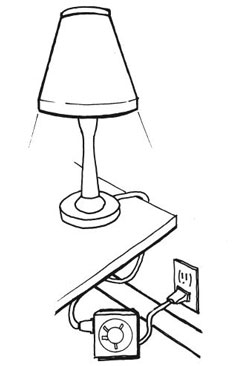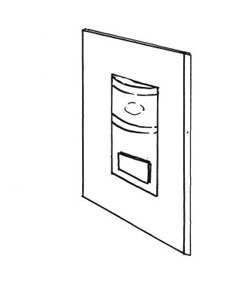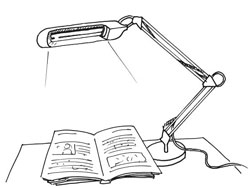Lighting Controls
In addition to saving energy by using more energy-efficient lamps, you can also save by leaving the lights on for a shorter period of time or dimming them. The simplest lighting control strategy, of course, is to turn lights off when you leave a room. Even if you are leaving for just a few minutes, it saves energy to turn the lights off. This applies to incandescent, fluorescent, and LED lights. The number and variety of controls available is growing as the technology develops along with consumer interest in home automation. Many new products allow you to control your lights from your smartphone so you can turn lights on and off or change control schedules even when you’re away from home. Check to make sure inexpensive controls are compatible with your lamps and fixtures.
With closets and cabinets, you can buy switches that turn the lights on when the door is opened and turn them off when the door is closed, thereby saving energy — as long as you remember to shut the door.
If you’re the type of person who forgets to turn off lights when you leave a room, consider installing occupancy sensors that automatically turn lights off once a room is vacant. Most of these work by sensing heat or motion. While used primarily in commercial buildings, they can save energy in the home as well.
Light-sensing controls are increasingly being used to control outdoor lights. If you currently turn outdoor lights on manually at night, these controls are a great convenience, and they can save even more energy if connected to a timer to turn the lights off sometime late at night. Motion-sensing controls for outdoor security lighting save energy and discourage potential intruders.
Another control strategy is to reduce light level and energy use with dimmers. LED lamps are readily dimmable, but make may need to swap out existing dimmers for those compatible with the LED lamps you purchase. Linear fluorescent lamps are dimmable only if they have dimming ballasts. Dimmable compact fluorescents have been introduced — check the packaging to determine whether a compact fluorescent will work with a dimmer. Dimming will reduce the energy consumed by fluorescent lamps without affecting efficiency. This is not so for incandescent lamps. Because of the way incandescent lights work, dimming to half the light output may still require three-quarters of the power.
Use Daylight
Nothing’s nicer than natural light, and in terms of energy use, nothing’s more efficient. A single skylight or properly positioned window can provide as much light as dozens of light bulbs during the daylight hours.
To benefit more from natural lighting, you may need to rearrange your rooms somewhat — putting your favorite reading chair over by the south window, for example. Or you may want to go to more effort and install one or more skylights. To help get that light deeper into the room, you can paint your walls a light color and use reflective louvers or venetian blinds.

Natural daylighting is the least expensive light source of all.
Another option is to install tubular skylights to bring daylight into rooms where traditional skylights aren’t feasible. Tubular skylights transmit daylight through a cylindrical tube from a small dome on the roof through the attic to a ceiling-mounted diffuser. The tube is lined with a highly reflective surface that channels daylight to the interior. The diffuser looks much like a conventional ceiling-mounted light fixture. As you plan for natural lighting, don’t forget that too much glass area on the east or west walls or on a south-facing roof can increase your air conditioning requirements. The best design balances passive solar heating, daylighting, and cooling considerations.
Match Your Light to the Task
You can save a lot of energy by concentrating light just where it’s needed and reducing background or ambient light levels. This strategy — called task lighting — is widely used in office buildings, but it makes just as much sense at home. Install track or recessed lights to illuminate your desk or the kitchen table where you do the crossword puzzle, and keep the ceiling lights off. Small LED and compact fluorescent lamps can be used in many locations. LED strip lights can focus additional illumination on countertops and other work surfaces.




